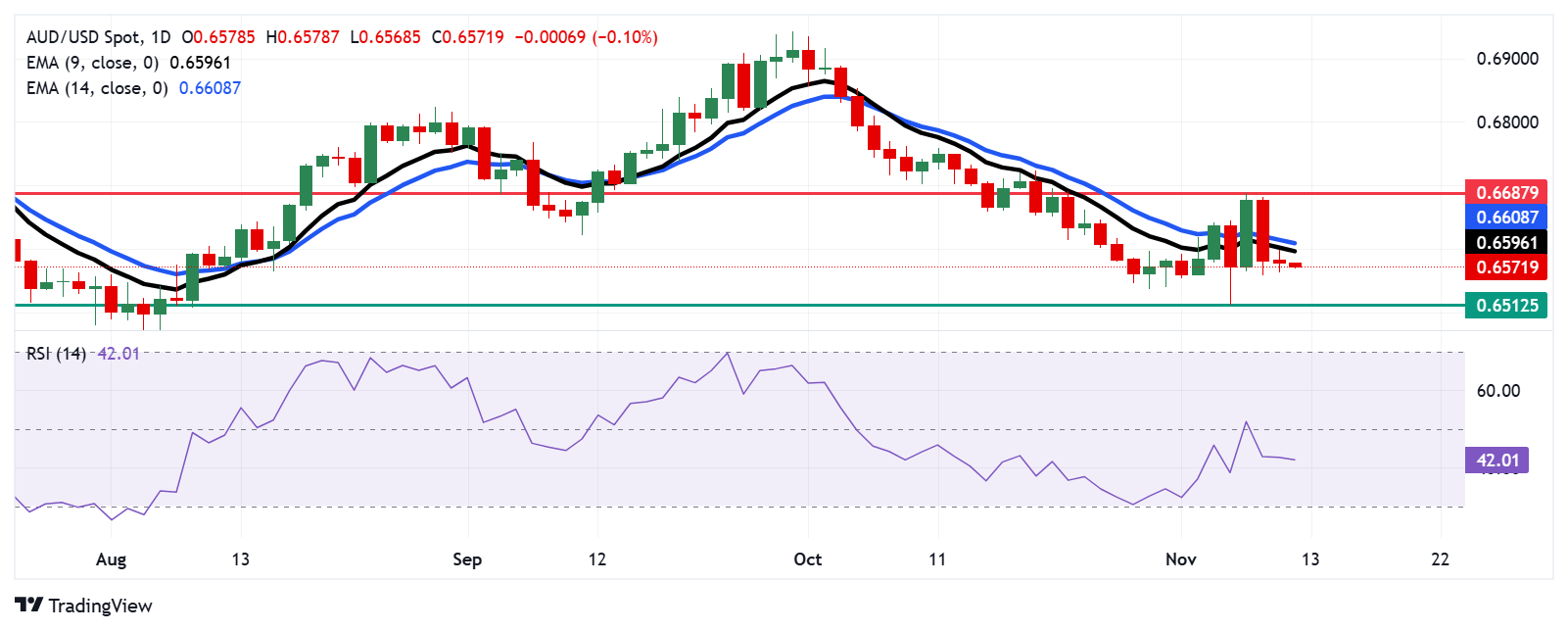- The Australian Dollar struggles due to concerns over potential tariffs on Chinese goods from US President-Elect Donald Trump.
- Australia's Westpac Consumer Confidence index increased by 5.3% in November, reaching 94.6 points.
- Traders await the US Consumer Price Index data release on Wednesday for insights into future US policy.
The Australian Dollar (AUD) depreciates against the US Dollar (USD) for the third consecutive session on Tuesday. Proposed tariff increases on Chinese goods by US President-Elect Donald Trump could negatively impact the AUD, as Australia is one of China’s largest exporters.
Australia's Westpac Consumer Confidence index rose by 5.3% to reach 94.6 points in November, marking its second consecutive month of improvement and the highest level in two and a half years. However, the index has remained below 100 for nearly three years, reflecting that pessimists still outnumber optimists.
Matthew Hassan, Senior Economist at Westpac, noted "Consumers are feeling less pressure on their family finances, are no longer worried about further interest rate rises, and are increasingly confident in the economic outlook."
The US Dollar continues to strengthen following the US election results that confirmed Trump’s victory. Analysts suggest that if Trump’s fiscal policies are implemented, they could boost investment, spending, and labor demand, raising inflation risks. This scenario might prompt the Federal Reserve (Fed) to adopt a more restrictive monetary policy, potentially strengthening the Greenback and putting added pressure on the AUD/USD pair.
Traders are awaiting the US inflation data release on Wednesday for insights into future US policy. The headline Consumer Price Index (CPI) is expected to show a 2.6% year-over-year increase for October, while the core CPI is projected to rise by 3.3%.
Daily Digest Market Movers: Australian Dollar depreciates amid concerns over Trump’s potential tariff
- Bloomberg News reported early Tuesday that Chinese regulators are planning to cut taxes on home purchases. According to the report, authorities are working on a proposal that would allow major cities to lower the deed tax for buyers to as low as 1%, down from the current maximum rate of 3%.
- The downside of the Australian Dollar could be restrained as the Reserve Bank of Australia (RBA) Governor Michele Bullock reiterated a hawkish stance after the interest rate decision last week, emphasizing the need for restrictive monetary policy given persistent inflation risks and a strong labor market.
- The AUD also struggled due to lower-than-expected Chinese Consumer Price Index (CPI) data released on Saturday. China’s Consumer Price Index (CPI) rose 0.3% year-over-year in October, slightly below market expectations and down from September’s 0.4%. This marks the ninth consecutive month of consumer price inflation but represents the lowest rate since June. Month-over-month, the CPI dropped by 0.3%, a sharper decline than the expected 0.1% decrease, following a flat reading in September.
- China's latest stimulus measures fell short of investor expectations, further dampening demand prospects for Australia’s largest trading partner and weighing on the Australian Dollar. China announced a 10 trillion Yuan debt package on Friday designed to alleviate local government financing pressures and support struggling economic growth. However, the package stopped short of implementing direct economic stimulus measures.
- Minneapolis Fed President Neel Kashkari stated on Sunday that the US economy has shown remarkable resilience as the Fed continues its efforts to curb inflation. However, Kashkari noted that the Fed is still “not all the way home.” He also mentioned that the Fed aims to be confident that inflation will fully return to the 2% target and needs additional evidence before considering another rate cut.
- Morgan Stanley divides the Trump administration's macroeconomic policies into three key areas: tariffs, immigration, and fiscal measures. The report predicts that tariff policies will be prioritized, with an anticipated immediate imposition of 10% tariffs globally and 60% tariffs specifically on China.
- On Thursday, Federal Reserve Chair Jerome Powell stated that he doesn’t anticipate Trump’s potential return to the White House impacting the Fed’s near-term policy decisions. “We don’t guess, speculate, and we don’t assume what future government policy choices will be,” Powell noted after the bank decided to lower interest rates by 25 basis points to a range of 4.50%-4.75%, as expected.
- Fed Chair Jerome Powell also emphasized that the Fed will continue to assess economic data to decide on the "pace and destination" of future rate changes, highlighting that inflation has been gradually slowing toward the Fed's 2% target.
Technical Analysis: Australian Dollar remains below the nine-day EMA near 0.6600
The AUD/USD pair trades around 0.6570 on Tuesday. An Analysis of the daily chart shows short-term downward pressure, as the pair remains below the nine-day Exponential Moving Average (EMA). Furthermore, the 14-day Relative Strength Index (RSI) consolidates below the 50 level, reinforcing the bearish outlook.
On the support side, the AUD/USD pair could test its three-month low of 0.6512, recorded on November 6. Further key psychological support is at 0.6500.
To the upside, immediate resistance is found at the nine-day EMA at 0.6596, followed by the 14-day EMA at 0.6609. A break above these EMAs might push the AUD/USD pair toward its three-week high of 0.6687, with the next psychological target at 0.6700.
AUD/USD: Daily Chart
Australian Dollar PRICE Today
The table below shows the percentage change of Australian Dollar (AUD) against listed major currencies today. Australian Dollar was the weakest against the Japanese Yen.
| USD | EUR | GBP | JPY | CAD | AUD | NZD | CHF | |
|---|---|---|---|---|---|---|---|---|
| USD | 0.11% | 0.18% | -0.12% | 0.14% | 0.29% | 0.07% | 0.04% | |
| EUR | -0.11% | 0.08% | -0.24% | 0.03% | 0.18% | -0.04% | -0.06% | |
| GBP | -0.18% | -0.08% | -0.32% | -0.05% | 0.10% | -0.13% | -0.13% | |
| JPY | 0.12% | 0.24% | 0.32% | 0.26% | 0.42% | 0.19% | 0.18% | |
| CAD | -0.14% | -0.03% | 0.05% | -0.26% | 0.15% | -0.07% | -0.08% | |
| AUD | -0.29% | -0.18% | -0.10% | -0.42% | -0.15% | -0.21% | -0.23% | |
| NZD | -0.07% | 0.04% | 0.13% | -0.19% | 0.07% | 0.21% | -0.03% | |
| CHF | -0.04% | 0.06% | 0.13% | -0.18% | 0.08% | 0.23% | 0.03% |
The heat map shows percentage changes of major currencies against each other. The base currency is picked from the left column, while the quote currency is picked from the top row. For example, if you pick the Australian Dollar from the left column and move along the horizontal line to the US Dollar, the percentage change displayed in the box will represent AUD (base)/USD (quote).
Australian Dollar FAQs
One of the most significant factors for the Australian Dollar (AUD) is the level of interest rates set by the Reserve Bank of Australia (RBA). Because Australia is a resource-rich country another key driver is the price of its biggest export, Iron Ore. The health of the Chinese economy, its largest trading partner, is a factor, as well as inflation in Australia, its growth rate and Trade Balance. Market sentiment – whether investors are taking on more risky assets (risk-on) or seeking safe-havens (risk-off) – is also a factor, with risk-on positive for AUD.
The Reserve Bank of Australia (RBA) influences the Australian Dollar (AUD) by setting the level of interest rates that Australian banks can lend to each other. This influences the level of interest rates in the economy as a whole. The main goal of the RBA is to maintain a stable inflation rate of 2-3% by adjusting interest rates up or down. Relatively high interest rates compared to other major central banks support the AUD, and the opposite for relatively low. The RBA can also use quantitative easing and tightening to influence credit conditions, with the former AUD-negative and the latter AUD-positive.
China is Australia’s largest trading partner so the health of the Chinese economy is a major influence on the value of the Australian Dollar (AUD). When the Chinese economy is doing well it purchases more raw materials, goods and services from Australia, lifting demand for the AUD, and pushing up its value. The opposite is the case when the Chinese economy is not growing as fast as expected. Positive or negative surprises in Chinese growth data, therefore, often have a direct impact on the Australian Dollar and its pairs.
Iron Ore is Australia’s largest export, accounting for $118 billion a year according to data from 2021, with China as its primary destination. The price of Iron Ore, therefore, can be a driver of the Australian Dollar. Generally, if the price of Iron Ore rises, AUD also goes up, as aggregate demand for the currency increases. The opposite is the case if the price of Iron Ore falls. Higher Iron Ore prices also tend to result in a greater likelihood of a positive Trade Balance for Australia, which is also positive of the AUD.
The Trade Balance, which is the difference between what a country earns from its exports versus what it pays for its imports, is another factor that can influence the value of the Australian Dollar. If Australia produces highly sought after exports, then its currency will gain in value purely from the surplus demand created from foreign buyers seeking to purchase its exports versus what it spends to purchase imports. Therefore, a positive net Trade Balance strengthens the AUD, with the opposite effect if the Trade Balance is negative.
Information on these pages contains forward-looking statements that involve risks and uncertainties. Markets and instruments profiled on this page are for informational purposes only and should not in any way come across as a recommendation to buy or sell in these assets. You should do your own thorough research before making any investment decisions. FXStreet does not in any way guarantee that this information is free from mistakes, errors, or material misstatements. It also does not guarantee that this information is of a timely nature. Investing in Open Markets involves a great deal of risk, including the loss of all or a portion of your investment, as well as emotional distress. All risks, losses and costs associated with investing, including total loss of principal, are your responsibility. The views and opinions expressed in this article are those of the authors and do not necessarily reflect the official policy or position of FXStreet nor its advertisers. The author will not be held responsible for information that is found at the end of links posted on this page.
If not otherwise explicitly mentioned in the body of the article, at the time of writing, the author has no position in any stock mentioned in this article and no business relationship with any company mentioned. The author has not received compensation for writing this article, other than from FXStreet.
FXStreet and the author do not provide personalized recommendations. The author makes no representations as to the accuracy, completeness, or suitability of this information. FXStreet and the author will not be liable for any errors, omissions or any losses, injuries or damages arising from this information and its display or use. Errors and omissions excepted.
The author and FXStreet are not registered investment advisors and nothing in this article is intended to be investment advice.
Recommended content
Editors’ Picks

AUD/USD holds steady near 0.6300; seems poised to register modest weekly losses
AUD/USD oscillates in a range around the 0.6300 mark on Friday and remains on track to end in the red for the first time in three weeks. Uncertainty over Trump’s tariffs, fears of slowing economic growth, a weaker risk tone, and disappointing Aussie jobs data released on Thursday act as headwinds for the pair.

USD/JPY looks to build on overnight bounce from weekly low; not out of the woods yet
USD/JPY edges higher following the release of Japan's National Core CPI, though it lacks bullish conviction amid the divergent BoJ-Fed policy expectations. Moreover, trade jitters, geopolitical risks, and a weaker risk tone could underpin the safe-haven JPY.

Gold price consolidates below record high; bullish bias remains
Gold price struggles to gain any meaningful traction on Friday as bulls now seem reluctant to place fresh bets after the recent strong move up to a record high and a modest USD uptick. However, persistent economic uncertainties amid Trump's trade tariffs and Fed rate cut bets should continue to support the non-yielding bullion.

XRP declines despite 400% growth in network activity
Ripple's XRP trades near $2.43 on Thursday after seeing a rejection at the $2.60 resistance. The remittance-based token has seen a 400% growth in network activity since the beginning of March.

Tariff wars are stories that usually end badly
In a 1933 article on national self-sufficiency1, British economist John Maynard Keynes advised “those who seek to disembarrass a country from its entanglements” to be “very slow and wary” and illustrated his point with the following image: “It should not be a matter of tearing up roots but of slowly training a plant to grow in a different direction”.

The Best brokers to trade EUR/USD
SPONSORED Discover the top brokers for trading EUR/USD in 2025. Our list features brokers with competitive spreads, fast execution, and powerful platforms. Whether you're a beginner or an expert, find the right partner to navigate the dynamic Forex market.
